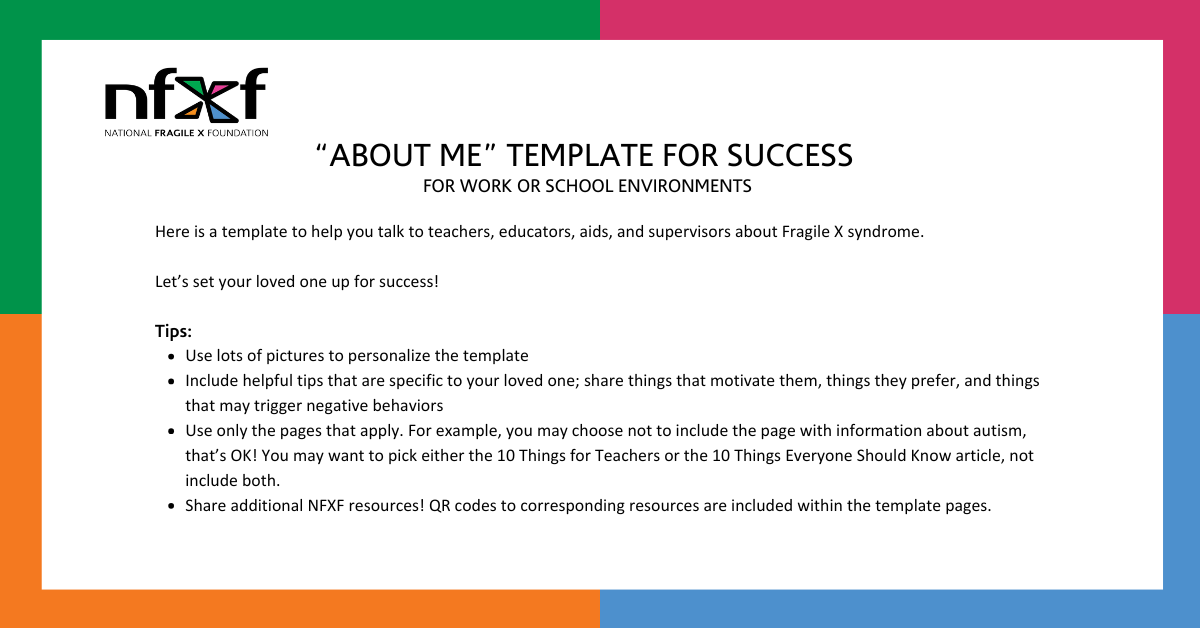With the school more than halfway gone, I am reminded about the significance of appropriate educational supports. In my role as a consultant, I have encountered on numerous occasions a lack of understanding about how important the learning environment is to behavioral outcomes. An interesting study by Symons, Clarke and Roberts (2001) concluded that effectively engaging children of elementary age who have FXS is strongly related to the environmental and instructional quality of teachers and classrooms. The authors found that the ways in which teachers structure and arrange the classroom environment is more important than the specific aspects of the child’s FX status such as severity of affectedness, medication usage or dual diagnosis.
This documents what we have experienced clinically for years. Best practice for those affected with FXS means providing a learning environment that allows them to access the curriculum in ways that minimize their disruptive behaviors and even further, without the teacher being overly concerned about the student’s functional levels or complex diagnoses.
Even though the Fragile X community has worked very hard to include children with FXS with their typical peers, the educational system often falls short in its mandate to provide a free and appropriate education. The issue of appropriate education has been debated through many due process hearings, culminating in a number of landmark special education decisions. In my view, an “appropriate” education requires accommodations and adaptations specific to a special education student’s condition.
For example, students with FXS have a keen sense of belonging, especially when they notice their level of performance is not on par with the typical peers surrounding them. This can have a significant impact on their behavior. Learning is contingent upon engagement. When a child is disengaged it becomes critical for educators to assess any factors that contribute to that disengagement.
One antecedent that is often overlooked when assessing a student’s engagement is the curriculum and lack of necessary adaptations. When there are students with FXS in a classroom, the curriculum must include adaptations that incorporate what we know about their learning style. If adaptations specific to FXS are not provided, the student may lack the skills to respond successfully.
It is not uncommon to observe students with FXS working hard to avoid curricular expectations, especially when their skill set is inadequate. The student with FXS may see no other option than to respond with some form of aberrant behavior in order to avoid the failure. Neglecting to account for this possibility when formatting an instructional model is a recipe for disaster. In addition, failing to consider the arrangement of the classroom and possible environmental adaptations may also contribute significantly to aberrant behaviors.
Too often, educators consider behavioral issues to be separate from the instructional program, making it easy to lose sight of the curricular factors that may be contributing to a problem behavior. With the reauthorization of the Individuals with Disabilities Education Act (IDEA), there is now an emphasis on implementing interventions that are scientifically based. It is no longer acceptable to determine special education eligibility simply on the basis of a student’s failure. Now, if the student fails, the intervention itself must be analyzed, along with the student’s response to the intervention.
This shift supports the need to implement appropriate intervention strategies that include remedies specific to the child’s condition, and long before a behavior intervention plan is developed. It also highlights the need to look beyond the identified behavior and to address other factors that might be contributing to the behavioral response.
The tendency to focus on isolated behavioral episodes before considering the environmental, curricular and instructional methodology is no longer accepted. The evidence is clear, the mandate has been clarified, and the students will ultimately thrive within this new approach to behavior intervention. The simple take-away lesson is this: Before your child’s teacher targets a specific behavior, he or she must carefully consider your child’s level of engagement and how it might be enhanced through environmental adaptation and instructional design.
Best Practice Supports for Children With Fragile X Syndrome
Environmental Accommodations
- Provide structure and predictability of schedule
- Provide opportunities to be included with typically developing peers
- Reduce level of noise, proximity of other students and EA’s
- Use natural lighting whenever possible
- Avoid crowded areas; help student gradually desensitize to large crowded environments
- Encourage opportunities to move
- Remove or minimize stressful events whenever possible
- Provide support for transitions, i.e. transitional object, job or task to rove from one location to another
Curricular Adaptations
- Use teaching triad (indirect instruction with another student)
- Provide small group instruction
- Provide visual supports such as charts, diagrams, pictures and color coding
- Provide nonverbal feedback
- Provide sensory intervention with an OT
- Use hands-on materials to teach math (and remember it is a very difficult academic area for these students)
- Teach reading using a visual approach
- Provide alternative means of responding to written tasks
- Use technology to augment writing
- Enhance learning by using high-interest material






